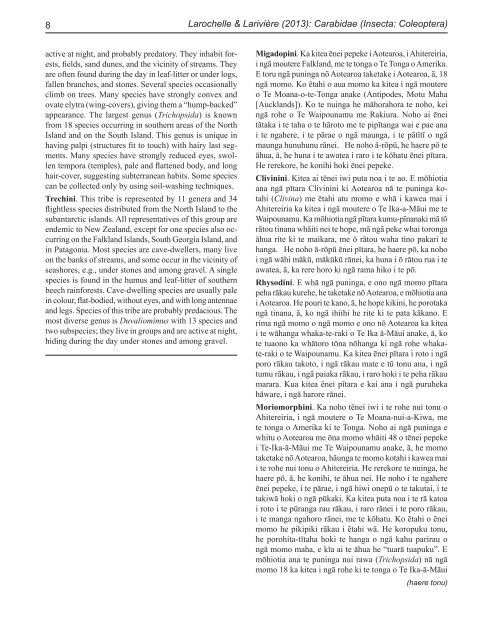Fauna of New Zealand 69 - Landcare Research
Fauna of New Zealand 69 - Landcare Research
Fauna of New Zealand 69 - Landcare Research
You also want an ePaper? Increase the reach of your titles
YUMPU automatically turns print PDFs into web optimized ePapers that Google loves.
8<br />
active at night, and probably predatory. They inhabit forests,<br />
fields, sand dunes, and the vicinity <strong>of</strong> streams. They<br />
are <strong>of</strong>ten found during the day in leaf-litter or under logs,<br />
fallen branches, and stones. Several species occasionally<br />
climb on trees. Many species have strongly convex and<br />
ovate elytra (wing-covers), giving them a “hump-backed”<br />
appearance. The largest genus (Trichopsida) is known<br />
from 18 species occurring in southern areas <strong>of</strong> the North<br />
Island and on the South Island. This genus is unique in<br />
having palpi (structures fit to touch) with hairy last segments.<br />
Many species have strongly reduced eyes, swollen<br />
tempora (temples), pale and flattened body, and long<br />
hair-cover, suggesting subterranean habits. Some species<br />
can be collected only by using soil-washing techniques.<br />
Trechini. This tribe is represented by 11 genera and 34<br />
flightless species distributed from the North Island to the<br />
subantarctic islands. All representatives <strong>of</strong> this group are<br />
endemic to <strong>New</strong> <strong>Zealand</strong>, except for one species also occurring<br />
on the Falkland Islands, South Georgia Island, and<br />
in Patagonia. Most species are cave-dwellers, many live<br />
on the banks <strong>of</strong> streams, and some occur in the vicinity <strong>of</strong><br />
seashores, e.g., under stones and among gravel. A single<br />
species is found in the humus and leaf-litter <strong>of</strong> southern<br />
beech rainforests. Cave-dwelling species are usually pale<br />
in colour, flat-bodied, without eyes, and with long antennae<br />
and legs. Species <strong>of</strong> this tribe are probably predacious. The<br />
most diverse genus is Duvaliomimus with 13 species and<br />
two subspecies; they live in groups and are active at night,<br />
hiding during the day under stones and among gravel.<br />
Larochelle & Larivière (2013): Carabidae (Insecta: Coleoptera)<br />
Migadopini. Ka kitea ēnei pepeke i Aotearoa, i Ahitereiria,<br />
i ngā moutere Falkland, me te tonga o Te Tonga o Amerika.<br />
E toru ngā puninga nō Aotearoa taketake i Aotearoa, ā, 18<br />
ngā momo. Ko ētahi o aua momo ka kitea i ngā moutere<br />
o Te Moana-o-te-Tonga anake (Antipodes, Motu Maha<br />
[Aucklands]). Ko te nuinga he māhorahora te noho, kei<br />
ngā rohe o Te Waipounamu me Rakiura. Noho ai ēnei<br />
tātaka i te taha o te hāroto me te pipītanga wai e pae ana<br />
i te ngahere, i te pārae o ngā maunga, i te pātītī o ngā<br />
maunga hunuhunu rānei. He noho ā-rōpū, he haere pō te<br />
āhua, ā, he huna i te awatea i raro i te kōhatu ēnei pītara.<br />
He rerekore, he konihi hoki ēnei pepeke.<br />
Clivinini. Kitea ai tēnei iwi puta noa i te ao. E mōhiotia<br />
ana ngā pītara Clivinini ki Aotearoa nā te puninga kotahi<br />
(Clivina) me ētahi atu momo e whā i kawea mai i<br />
Ahitereiria ka kitea i ngā moutere o Te Ika-a-Māui me te<br />
Waipounamu. Ka mōhiotia ngā pītara kumu-pīnanaki mā tō<br />
rātou tinana whāiti nei te hope, mā ngā peke whai toronga<br />
āhua rite ki te maikara, me ō rātou waha tino pakari te<br />
hanga. He noho ā-rōpū ēnei pītara, he haere pō, ka noho<br />
i ngā wāhi mākū, mākūkū rānei, ka huna i ō rātou rua i te<br />
awatea, ā, ka rere horo ki ngā rama hiko i te pō.<br />
Rhysodini. E whā ngā puninga, e ono ngā momo pītara<br />
peha rākau kurehe, he taketake nō Aotearoa, e mōhiotia ana<br />
i Aotearoa. He pouri te kano, ā, he hope kikini, he porotaka<br />
ngā tinana, ā, ko ngā ihiihi he rite ki te pata kākano. E<br />
rima ngā momo o ngā momo e ono nō Aotearoa ka kitea<br />
i te wāhanga whaka-te-raki o Te Ika ā-Māui anake, ā, ko<br />
te tuaono ka whātoro tōna nōhanga ki ngā rohe whakate-raki<br />
o te Waipounamu. Ka kitea ēnei pītara i roto i ngā<br />
poro rākau takoto, i ngā rākau mate e tū tonu ana, i ngā<br />
tumu rākau, i ngā paiaka rākau, i raro hoki i te peha rākau<br />
marara. Kua kitea ēnei pītara e kai ana i ngā puruheka<br />
hāware, i ngā harore rānei.<br />
Moriomorphini. Ka noho tēnei iwi i te rohe nui tonu o<br />
Ahitereiria, i ngā moutere o Te Moana-nui-a-Kiwa, me<br />
te tonga o Amerika ki te Tonga. Noho ai ngā puninga e<br />
whitu o Aotearoa me ōna momo whāiti 48 o tēnei pepeke<br />
i Te-Ika-ā-Māui me Te Waipounamu anake, ā, he momo<br />
taketake nō Aotearoa, hāunga te momo kotahi i kawea mai<br />
i te rohe nui tonu o Ahitereiria. He rerekore te nuinga, he<br />
haere pō, ā, he konihi, te āhua nei. He noho i te ngahere<br />
ēnei pepeke, i te pārae, i ngā hiwi onepū o te takutai, i te<br />
takiwā hoki o ngā pūkaki. Ka kitea puta noa i te rā katoa<br />
i roto i te pūranga rau rākau, i raro rānei i te poro rākau,<br />
i te manga ngahoro rānei, me te kōhatu. Ko ētahi o ēnei<br />
momo he pikipiki rākau i ētahi wā. He koropuku tonu,<br />
he porohita-tītaha hoki te hanga o ngā kahu parirau o<br />
ngā momo maha, e kīa ai te āhua he “tuarā tuapuku”. E<br />
mōhiotia ana te puninga nui rawa (Trichopsida) nā ngā<br />
momo 18 ka kitea i ngā rohe ki te tonga o Te Ika-ā-Māui<br />
(haere tonu)
















